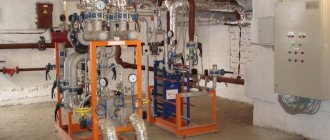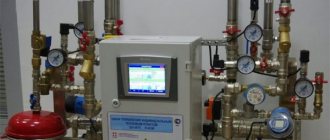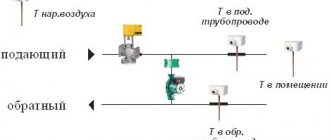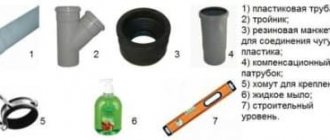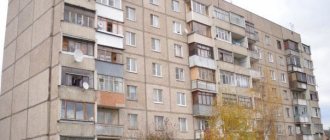Connecting heat supply in an apartment building
Before organizing heat supply to non-residential premises, it is necessary to carry out a primary analysis of the characteristics of the building.
To complete this step correctly you need:
- Select the thermal operating mode based on the purpose of the room.
- Calculate heat supply using dimensional indicators as a basis.
- Decide which coolant will be used.
Based on the information obtained as a result of the mentioned procedures, the method by which the room will be heated is selected.
Then everything is done like this:
- Activities are carried out as a result of which it becomes possible to supply coolant to non-residential areas, that is, the necessary communications are supplied.
- Do not forget that heating does not appear by itself. For everything to work, you need to conclude an agreement with heat suppliers for its supply.
Important. It is worth noting that any project of an administrative or industrial building should begin with an analysis of possible types of heating.
When assessing a room, special attention should be paid to its heat losses. If calculations show that they are too large, then you can resort to additional thermal insulation by installing it on the heated area. In this way, you can achieve a tangible effect.
Choosing a method for heating buildings
Zone heating
It must be remembered that heating livestock buildings differs from a similar heating system for a commercial or industrial building.
Currently, there are many methods for ensuring that indoor air is heated to the desired level. For this, various equipment and components are used. The difference lies in the schemes and methods of ensuring normal temperature levels.
Water heating of non-residential buildings
Water heating of the workshop
Among all the methods of heating premises, this is one of the most common. The heat supply circuit consists of a source of thermal energy (boiler), pipelines through which the heated coolant passes, as well as radiators, batteries and registers.
The heating of a commercial space made in this way can be easily adapted to different types of energy carriers - gas, solid or diesel fuel. To do this, you only need to replace or upgrade the boiler. There is no need to change the configuration of the rest of the system.
However, along with this, it is necessary to take into account the operating features of heating large premises of this type. It involves high maintenance costs, since it is necessary to constantly maintain a comfortable temperature to a significant extent. In addition, when organizing heating of non-residential premises, the following factors should be taken into account:
- Possible impact on the coolant of negative temperatures in winter. This can lead to freezing and damage to the pipeline;
- System inertia . The air heating time is directly dependent on the volume of the room;
- Possible problems with thermal distribution . The air temperature will be higher near heating devices.
This method is applicable for heating livestock buildings if the level of air heating in them must be constant. In all other cases, it is best to consider other heat supply options.
For autonomous water heating of warehouses, it is necessary to properly arrange the boiler room. Its operation should not interfere with the main production process.
Air heating of buildings
Chiller-francoil heating
One of the new and effective ways to heat a commercial space is to install an air circuit. It is called the chiller-francoil system.
This type of heat supply consists of two elements - a chiller and francoil units installed in the building. The first one is mounted not inside the house, but on its roof. The operation of the chiller is based on the principle of a heat pump. In its primary circuit, a refrigerant circulates, the temperature of which rises as the pressure increases. The resulting energy is transferred through the heat exchanger to the internal circuit, which is connected to the mains using pipelines. They, in turn, connect to the free coils.
Before installing such a system, an accurate and scrupulous calculation of the heating of the room will be required. During its implementation, internal and external factors are taken into account - climatic features of the region, characteristics of the building, etc. This task should be performed by special design bureaus.
The main advantages of air-type commercial heating:
- The system can operate both for heating (in winter) and for cooling air (in summer);
- Possibility of installing additional free coils in other rooms of the building;
- High speed of air heating and organization of zone heating of premises;
- Adjustment of the operating mode of each frankoil. This allows you to set the optimal air heating mode in individual rooms.
It is important to correctly calculate the heat for heating the room, since depending on this, a chiller of a certain power and performance will be selected. Depending on the type of coolant used, it can be with a water circuit or air. The latter can be used to supply heat to small and medium-sized buildings and production workshops. The cost of a chiller-francoil system can be from 700 thousand rubles. Therefore, it is so important to calculate the feasibility of its installation.
Spot heat supply of production areas
The principle of operation of infrared heating
How to optimize the costs of heat supply to non-residential premises? To do this, you can use a fundamentally different air heating scheme. At the same time, despite the high tariff for heating non-residential premises, significant energy savings will be observed.
We are primarily talking about spot heating. Its difference from the traditional one lies in the distribution of heat in a certain volume of the room, and not over its entire area. This applies to heating warehouses, where it is necessary to create an individual thermal regime in individual zones.
There are several ways to organize this type of heating. The most effective is to install gas IR emitters. In them, when gas is burned, infrared radiation is formed, which is focused onto a certain area using a reflector.
Heater diagram
Using similar electrical devices, it is possible to organize heating of livestock farms, where it is necessary to maintain the desired temperature level in only one area of the room. In this case, experts take into account the following points:
- Using IR heaters as an auxiliary system for quickly heating a room. For further work, you can install electric boilers for space heating or their solid fuel and gas analogues;
- During operation of the heaters, the air does not heat up. The temperature on the surface of objects that fall within the range of the devices increases;
- When performing room heating calculations, the ventilation system must be taken into account. In particular, the intensity and frequency of complete air replacement. This refers to the inevitable heat losses of heating.
In addition, it is important to select the correct power of the devices, as well as ensure the safety of their operation. Compliance with safety regulations is a priority when planning heating.
If the location of the heating area will constantly change, it is recommended to purchase mobile infrared heaters. They are convenient for organizing heating of a sales area with a different range of goods.
Electric heating for commercial premises
Electrode boilers
For rooms with a small area, you can install electric heat supply. For this purpose, special electric boilers are installed for heating non-residential premises - electrode or induction. They are characterized by their small size and the ability to be installed in limited areas.
Taking into account heating tariffs for non-residential premises, they will not be the most appropriate. In any case, you will have to make a pipeline system, install radiators and batteries. As an alternative, you can consider installing electric heaters.
Electric heater design
They cannot be used to heat large rooms and premises, as this will entail too high costs. Installation of electric convectors is only relevant if the following conditions are met:
- There is no possibility of organizing gas or infrared heating;
- The electrical network is designed for maximum operating power of all electrical appliances;
- Installation of two tariff meters to optimize costs. With good thermal insulation, heating of non-residential premises can be organized in night mode. During the day, turn on the radiators only when the temperature drops critically.
It is because of these factors that it is desirable to install electric heating boilers in non-residential premises. The water system in this case will require lower heating costs.
The best way to heat non-residential buildings and premises is one in which the heat supply system has an efficiency index of at least 85%.
What legislation and regulations regulate heat payments?
Since it is possible to provide heating in non-residential premises, someone must pay for the heat. This fact is clearly stated in Decree of the Government of the Russian Federation No. 354.
also clearly defines the formulas used to calculate the amounts paid for heating non-residential premises.
The aforementioned legislative act also stipulates that the calculation of the heating payment amount using the indicated formula can be carried out if we are talking about non-residential space in an apartment building that has a collective, that is, a common house-wide meter for incoming thermal energy.
However, in such a situation, in a particular building, not all areas, both residential and non-residential, can be equipped with individual meters. Moreover, the resolution in question contains not only information regarding payment for heating of non-residential premises.
It also includes formulas by which, under certain conditions, calculations can be made to pay for heating residential areas. also described contains information regarding the calculation of payment for other housing and communal services such as hot and cold water supply, electricity, etc.
On heating non-residential premises in an apartment building. Educational program from the Armed Forces
On the one hand, being the owner of non-residential premises in an apartment building is a little easier than in a non-residential building, because relations both with neighbors and with the RSO and ICU (MC, HOA, TSN, etc.) are more or less regulated.
On the other hand, this regulation sometimes leads to a somewhat unfair situation, since if some of the premises in an apartment building have some characteristics, and some others, we potentially run the risk that one norm for everyone will discriminate against someone.
An example is the long-suffering heating of premises in apartment buildings in general and non-residential premises in particular.
I already wrote about this issue in my essay.
The legislation in 2022, after a number of comments by the Constitutional Court of the Russian Federation and the Supreme Court of the Russian Federation, changed and began to take into account the individual characteristics of the premises (heated or not, whether there are heating devices or not, whether there are metering devices or not).
But, firstly, before 2022, quite a lot of relationships had developed regarding the supply of thermal energy to the premises of apartment buildings, and secondly, modern legislation has also not fully regulated the issue.
The RF Armed Forces again began to look into finding a correct and fair mechanism for determining heating fees in a series of cases, for which we are very grateful.
The first case, the consideration of which has been completed, is A53-39337/2017.
Its essence is simple: the owner of a non-residential premises, which was heated, took steps to reconstruct it by removing heating devices and connecting to an individual heat source (gas boiler room).
The court of first instance, on the basis of Rules 354, satisfied the claim of the HOA for the collection of heating fees; the court of appeal and cassation did not support this decision and refused to satisfy the claim.
The claim period is 03/01/2015 to 04/15/2017 (it should be noted during this period that the position of the RF Armed Forces on heating from risers and transit heat supply networks appeared and the rules for determining the counterparty and the amount of payment for heating in the non-residential premises of an apartment building changed).
The Supreme Court also speaks about this, interpreting Rule 354 in a slightly expansive but fair way as amended until 2022:
“The changes introduced from January 1, 2017 by Decree of the Government of the Russian Federation dated December 26, 2016 No. 1498 to Rule No. 354 provide that the supply of cold water, hot water, thermal energy, electrical energy and gas to non-residential premises in an apartment building, as well as the removal wastewater is carried out on the basis of resource supply contracts concluded in writing directly with the resource supplying organization (clause 6 of Rules No. 354). At the same time, the organization managing the apartment building retained the right to demand from the owners of non-residential premises the cost of utilities provided for general house needs (clause 40 of Rules No. 354).
In this regard, the partnership
, chosen by the owners to manage the apartment building in December 2014 and which entered into a heat supply agreement with a resource supply organization in February 2015 to provide communal heat supply services to the owners of residential and non-residential premises, contrary to the conclusions of the courts of appeal and the district,
has the right to demand payment of the cost of the heating service
until 01/01/2017 in in full,
and after 01/01/2017 - at least in the amount attributable to general house needs.”
That is, despite the modern edition of Rule 354 (according to it and according to the old edition, both communal and individual heating is billed by RSO), the RF Armed Forces believes that heating in terms of communal consumption is paid for by the ICU. Formally, legally, in relation to the periods from January 2022 to December 2022, the Supreme Court of the Russian Federation is right, but wouldn’t it be more correct to point out that the issue of heating from 2022, in principle, is not an issue for the HOA; this conclusion, after all, can also be justified teleologically by interpreting Rules 354.
Regarding the issue of admissibility by dismantling the heating system or in the absence of heating devices, in principle, not paying for heating should be decided, in the opinion of the RF Armed Forces, according to the following standard of proof.
1. It is assumed that any room through which the heating system passes in an apartment building is heated.
2. This presumption is rebuttable, including by reference to the old definition of the RF Armed Forces, the owner of a premises without heating devices must prove complete thermal insulation of heating networks, including risers. Also, if the owner has removed the heating appliances, he must also prove, despite the thermal insulation, that he did it legally. In rules 354, the legislator makes a remark in this regard, that until the ban on individual heating of premises in apartment buildings appears, the removal of heating appliances is legal.
3. Further, the Supreme Court points out that if, when the specified circumstances are identified, the premises do not individually consume thermal energy from risers and transit networks, then at least the general house consumption attributable to it must be calculated.
And this calculation must be made either with the involvement of an expert, or by analogy applying the currently valid version of Rule 354 to periods up to 2022.
On June 17, 2019, another case A60-61074/2017 was considered on the same issue, where the Supreme Court drew attention to the design documentation of the house, according to which heating is provided in the Defendant’s non-residential premises due to heat transfer from transit pipes. That is, in fact, the Supreme Court has already predetermined the outcome of the case in favor of the Plaintiff, although it seems to me that there is a nuance taking into account the position of the Constitutional Court of the Russian Federation on premises without heating devices.
On July 24, 2019, the third case A57-363/2018 (claim period October 2016 to April 2022) will be considered, which will also concern the transition to individual heating.
Calculation formula
As mentioned above, the formula by which the heating of a non-residential space, such as a basement, is calculated, is clearly stated in Decree of the Government of the Russian Federation No. 354.
The formula looks like this: P = S x V x T. Where:
- S is the total area of a certain room located in an apartment building.
- V is the volume of thermal energy consumed on an average monthly basis and calculated over the past year. It is calculated as the ratio of the readings of a common building meter to the number of calendar months in a year and the total area of both residential and non-residential areas located in the apartment building.
- T is the tariff for incoming heat, clearly indicated as required by the laws of the Russian Federation.
It is worth noting that the result obtained using the above formula may be adjusted when the first quarter of next year arrives. Thus, the calculation of heating in non-residential premises is clearly regulated by the legislation of the Russian Federation .
All possible adjustments are clearly stated in the above-mentioned resolution. Thanks to him, any deviation from the formulas established by law is an illegal act. If a citizen accidentally or deliberately made such a mistake, then he can be held accountable in accordance with the law.
How does it work in practice?
As mentioned above, such a calculation is made according to the formula: P = S x V x T. This means that if the area of the room is 34 square meters, the amount of thermal energy consumed on average is 0.085 Gcal, and the tariff for heating supplied to the room is 1371, then 34 x 0.085 x 1371 = 3962.1 rub.
Do not forget that if a heat meter is installed in the building, then the management company must make all calculations in the shown way and not otherwise.
In such a situation, the payment calculation procedure should consist of several steps. First, you should coordinate the total area of the real estate with the size of the specific non-residential premises.
Then everything is done like this:
- The readings of the common house meter are reconciled at the beginning and end of the paid period of time.
- The resulting difference should be considered the total energy consumption of the MKD.
- Next, the ratio of the area of the room and the size of the entire structure is calculated.
- The value of the heat tariff is determined. Such information can be obtained from an authorized employee of the management company.
Attention. If you do not follow the steps described and do not obtain the information mentioned, then it will be impossible to calculate using the indicated formula.
How does the heat turn off?
According to current legislation, neither the owner of the premises nor the HOA can stop heating non-residential premises in an apartment building. The heat will not be turned off, even if the owner has a huge debt to pay for it. In this case, according to the law, the heat supplier must legally collect debts from the owner of the area , and not turn off the heating.
This phenomenon is due to the fact that stopping the heat supply can affect the operation of a room not intended for living. Thus, stopping the supply of coolants that provide a favorable temperature is very difficult to achieve, especially considering the fact that such an act is considered illegal and entails criminal liability.
If the owner of the premises voluntarily wants to turn off the heating of a non-residential premises in an apartment building, then nothing will work out for him either, since this contradicts the Decree of the Government of the Russian Federation No. 354.
Payment for heating, as well as its calculation, differs little from those established for residential areas , especially considering that the calculation formulas for them are prescribed in one legislative act.
However, there are still some differences, and it is best for owners of areas not intended for residential use to familiarize themselves with them in order to avoid possible problems and difficulties in the future.



